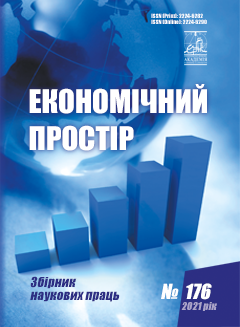METHODOLOGY OF ANALYSIS OF THE CONTENT OF ELECTRONIC MEDIA
Abstract
In the conditions of modern information society, the analysis of the flow of media information is of particular importance. Therefore, the issues of content analysis, which is based on the conversion of qualitative data into digital format in order to obtain information processing capabilities using technologies of big-data analytics and artificial intelligence approaches, are especially relevant. This study summarized the views on the use of content analysis and proposed a methodology for analyzing the content of electronic media for targeting and determining preferences for the content of publications. For this purpose, were proposed were proposed a conceptual scheme for conducting content analysis, which consists of 5 stages. The first stage consists of creating and updating a full-text database on a daily basis by automated data collection and retrieval of content from media websites (web scraping). The second stage involves using of modules for determining useful content (parsing) and its subsequent storage in the database. The quantitative analysis stage is especially important when generalization, aggregation of results, or to calculate the frequency of words (frequency analysis), categories, tags and expressions, as well as their joint use in the text. The purpose of qualitative analysis is to reduce the material so that the main content remains. Similarly, qualitative analysis can provide additional information about individual components of the text (terms, definitions) in order to improve understanding, explanation, and interpretation of a particular passage. Finally, the last stage is to analyze the tone of the texts (sentiment analysis), i.e. to determine the emotional (positive or negative) attitude of the authors of the test to the described event, person or phenomenon. Authors (or users who leave comments) actively use various means in order to create the desired picture of an event in the reader’s imagination, and to evoke the appropriate emotions. The proposed methodology is the basis for the implementation of modern tools of content analysis using information technologies and methods artificial intelligence approaches.
References
Krippendorff K. Validity in content analysis. Computerstrategien fur die kommunikationsanalyse. Frankfurt, Germany : Campus, 1980. P. 69–112. URL: http://repository.upenn.edu/asc_papers/291 (дата звернення: 06.12.2012).
Krippendorff K. Content analysis. International encyclopedia of communication. New York, NY : Oxford University Press, 1989. Vol. 1. P. 403–407. URL: http://repository.upenn.edu/asc_papers/226 (дата звернення: 06.12.2012).
Lacy S., Riffe D., Stoddard S., Martin H., Chang K. Sample Size for Newspaper Content Analysis in Multi-Year Studies. Journalism & Mass Communication Quarterly. 2001. Vol. 78. No. 4. P. 836–845. DOI: https://doi.org/10.1177/107769900107800414.
Aaldering L., Vliegenthart R. Political leaders and the media. Can we measure political leadership images in newspapers using computer-assisted content analysis? Qual Quant. 2016. Vol. 50. P. 1871–1905. DOI: https://doi.org/10.1007/s11135-015-0242-9.
Mayring P. Qualitative content analysis: theoretical foundation, basic procedures and software solution. Klagenfurt. 2014. URL: https://nbn-resolving.org/urn:nbn:de:0168-ssoar-395173 (дата звернення: 08.12.2012).
Kuckartz U. Qualitative Text Analysis: A Systematic Approach. Compendium for Early Career Researchers in Mathematics Education, ICME-13 Monographs. 2019. DOI: https://doi.org/10.1007/978-3-030-15636-7_8.
Skalski P.D., Neuendorf K.A., Cajigas J.A., Content Analysis in the Interactive Media Age. The Content Analysis Guidebook. 2017. URL: https://academic.csuohio.edu/kneuendorf/SkalskiVitae/SkalskiNeuendorfCajigas17.pdf (дата звернення: 12.12.2012).
Іванов О.В. Класичний контент-аналіз та аналіз тексту: термінологічні та методологічні відмінності. Вісник Харківського національного університету імені В.Н. Каразіна. 2013. № 1045. С. 69–74. URL: http://ekmair.ukma.edu.ua/bitstream/handle/123456789/7244/VKhISD_2013_1045_30_13.pdf (дата звернення: 16.12.2012).
Іванов О.В. Комп’ютерний контент-аналіз: проблеми та перспективи вирішення. Методологія, теорія та практика соціологічного аналізу сучасного суспільства. 2009. Вип. 15. С. 335–340. URL: http://ekmair.ukma.edu.ua/bitstream/handle/123456789/2407/Ivanov%20komjuternyi%20analiz.pdf (дата звернення: 16.12.2012).
Трепачко Д.Ю. Особливості застосування контент-аналізу в дослідженнях новинних повідомлень ЗМІ. Вісник Національного технічного університету України «Київський політехнічний інститут». 2010. № 1 (5). С. 87–91. URL: https://ela.kpi.ua/bitstream/123456789/6048/1/10-1%285%29-15.pdf (дата звернення: 16.12.2012).
Semantrum. Онлайн-сервіс для моніторингу традиційних та Інтернет-ЗМІ. URL: https://promo.semantrum.net/uk/golovna (дата звернення: 22.12.2012).
Semantria for Excel. Text and sentiment analysis for surveys, social media, and reviews. URL: https://www.lexalytics.com/semantria/excel (дата звернення: 22.12.2012).
Krippendorff, K. (1980). Validity in content analysis. Computerstrategien fur die kommunikationsanalyse (pp. 69–112). Frankfurt, Germany: Campus. URL: http://repository.upenn.edu/asc_papers/291 (accessed 6 December 2021).
Krippendorff, K. (1989). Content analysis. International encyclopedia of communication (Vol. 1, pp. 403–407). New York, NY: Oxford University Press. Available at: http://repository.upenn.edu/asc_papers/226 (accessed 6 December 2021),
Lacy, S., Riffe, D., Stoddard, S., Martin, H., and Chang, K. (2001). Sample Size for Newspaper Content Analysis in Multi-Year Studies. Journalism & Mass Communication Quarterly. Vol. 78. No. 4, pp. 836–845. DOI: https://doi.org/10.1177/107769900107800414.
Aaldering, L., Vliegenthart, R. (2016) Political leaders and the media. Can we measure political leadership images in newspapers using computer-assisted content analysis? Qual Quant. Vol. 50, pp. 1871–1905. DOI: https://doi.org/10.1007/s11135-015-0242-9.
Mayring, P. (2014). Qualitative content analysis: theoretical foundation, basic procedures and software solution. Klagenfurt. Available at: https://nbn-resolving.org/urn:nbn:de:0168-ssoar-395173 (accessed 8 December 2021).
Kuckartz, U. (2019). Qualitative Text Analysis: A Systematic Approach. Compendium for Early Career Researchers in Mathematics Education, ICME-13 Monographs. DOI: https://doi.org/10.1007/978-3-030-15636-7_8.
Skalski, P.D., Neuendorf, K.A., Cajigas, J.A. (2017). Content Analysis in the Interactive Media Age. The Content Analysis Guidebook. Available at: https://academic.csuohio.edu/kneuendorf/SkalskiVitae/SkalskiNeuendorfCajigas17.pdf (accessed 12 December 2021).
Ivanov, O.V. (2013). Klasychnyi kontent-analiz ta analiz tekstu: terminolohichni ta metodolohichni vidminnosti [Classical content analysis and text analysis: terminological and methodological differences]. Visnyk Kharkivskoho natsionalnoho universytetu imeni V.N. Karazina. 1045, pp. 69–74. Available at: http://ekmair.ukma.edu.ua/bitstream/handle/123456789/7244/VKhISD_2013_1045_30_13.pdf (accessed 16 December 2021).
Ivanov, O.V. (2009). Kompiuternyi kontent-analiz: problemy ta perspektyvy vyrishennia [Computer Content Analysis: Problems and Prospects]. Metodolohiia, teoriia ta praktyka sotsiolohichnoho analizu suchasnoho suspilstva. Vol. 15, pp. 335–340 Available at: http://ekmair.ukma.edu.ua/bitstream/handle/123456789/2407/Ivanov%20komjuternyi%20analiz.pdf (accessed 16 December 2021).
Trepachko, D.Iu. (2010). Osoblyvosti zastosuvannia kontent-analizu v doslidzhenniakh novynnykh povidomlen ZMI [Features of the application of content analysis in the study of news media reports]. Visnyk Natsionalnoho tekhnichnoho universytetu Ukrainy “Kyivskyi politekhnichnyi instytut”. 1 (5), pp. 87–91. Available at: https://ela.kpi.ua/bitstream/123456789/6048/1/10-1%285%29-15.pdf (accessed 16 December 2021).
Semantrum. AI-platform for media analytics and reputation management. Available at: https://promo.semantrum.net/en/main (accessed 22 December 2021).
Semantria for Excel. Text and sentiment analysis for surveys, social media, and reviews. Available at: https://www.lexalytics.com/semantria/excel (accessed 22 December 2021).



